Nov 25, 2025
Nov 25, 2025
Director: Miklos Jancso / Hungary/Hungarian/95 mts
Compact and complex, straightforward, yet still obtuse, and brimming with claustrophobia amid a sprawling Hungarian landscape, Miklós Jancsó’s The Round-Up (Szegénylegények) is a film full of powerful contradictions. What we see and hear (or read) has less impact in a vacuum than the cumulative nature of witnessing repeated atrocities greater than mere physical death. The Round-Up is pure, one-sided psychological warfare and one the greatest films to come out of Hungary.
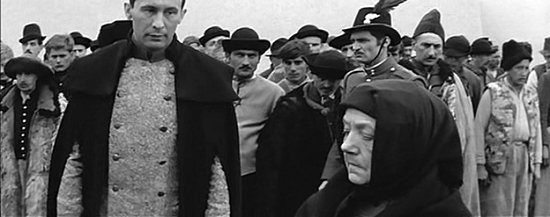
Aged woman makes identification parade
On a raining afternoon in a remote Hungarian countryside at some indeterminate time after the collapse of the 1848 revolution against Austrian rule, an unassuming man is led away from the oddly surreal congregation of weary prisoners who have been assembled at the courtyard of a detention camp on nebulous grounds of suspicious activity. The camera then fluidly tracks the movements of the characters as the prisoner is escorted by an enigmatic, cloaked official into a room of a nearby abandoned farmhouse, encounters another official on the premises who, in turn, walks towards the rear of the farmhouse for his appointment: an aging peasant woman (Ida Siménfalvy) summoned to identify the remains of her husband and son. The first official methodically and dispassionately reveals that the man has been arrested for smuggling propaganda from an exiled patriot and revolutionary leader, Louis Kossuth, into Hungary, but curiously, sets him free. In an understatedly elegant long shot, the man is observed walking away before a shot breaks the silence of the idyllic pastoral landscape, and the man falls to the ground. Meanwhile, returning to the prison camp, the old woman identifies the cowardly Janos Gajdar (János Görb) as one of the roving outlaws, and is immediately brought before the interrogators. With little hope of escaping the gallows, Janos attempts to bargain for his life by acting as an informant for the Austrian gendarmes and in the process, initiates a cycle of betrayal, violence, and deceit in an attempt to ferret out the revolutionaries from the randomly assembled prisoners.
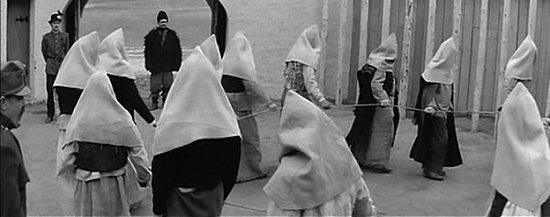
A group of hooded prisoners shuffles around in a circle
Miklós Jancsó creates a sublime, provocative, and haunting examination of moral bankruptcy and human cruelty in The Round-up. A profound influence on the spiritually bleak and alienated cinema of Hungarian compatriot Béla Tarr, Jancsó's signature detached long shots and spare, omniscient crane shots reinforce the insidious, distrustful, and uncertain landscape of Hungary after the failed revolution: the opening shot of the prisoner roundup against the image of the setting sun on the barren plains; the overhead shot of the captured insurgent's assassination that tracks to a shot of the crowded prison yard; the circular procession of shackled, hooded prisoners as they return to their holding cells; the chaotic lashing of a woman that proves to be a catalyst for disillusioned prisoners committing suicide. Through languid and sweeping pans, minimal composition, and oppressive environment that reflect the emotional vacuity, hopelessness, and isolation of the detained prisoners, The Round-up presents an understated, yet harrowing portrait of spiritual desolation, betrayal, and existential limbo.
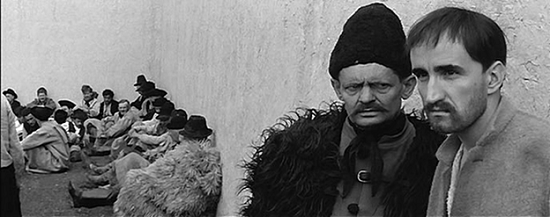
Janos Gajdar identifies a prisoner who was a revolutionary
What one gets, though, is a series of shots of such formal magnificence that they seem at first glance to work against the grim, oppressive, quasi-Kafkaesque scenario. Using every inch of the wide CinemaScope screen (a pan-and-scan version of this film would be criminal vandalism), Jancsó’s images recall Sergio Leone’s in The Good, the Bad and the Ugly and Once Upon a Time in the West - though Leone hadn’t reached anything like this level by 1965. Groups of horsemen thunder past either side of the camera to join their companions on the horizon, creating a startling three-dimensional effect, and throughout the film Jancsó is careful to compose for every plane - the far distance is as likely to feature people and horses in intricate geometrical arrangements as the foreground.
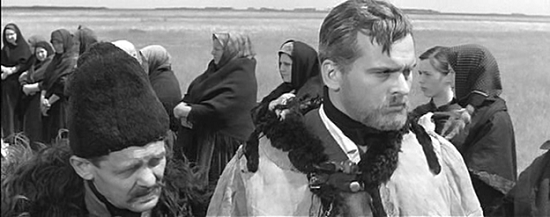
Janos Gajdar walk with a revolutionary for identifying his wife
The film often has more in common with dance than cinema: a group of hooded prisoners shuffles around in a circle, soldiers form two parallel lines to repeatedly whip a naked girl, and black-clad old women bring white bundles of provisions that are laid out in a perfectly straight line. Jancsó often shoots from a high vantage point, as if to emphasize the massive scale of his canvas, and in the many sequences featuring literally hundreds of people, one can only marvel at how long they must have taken to set up. The soundtrack is clearly post-dubbed, as Jancsó liked to give directions during his long takes, aping his silent-movie forebears of four or five decades earlier.
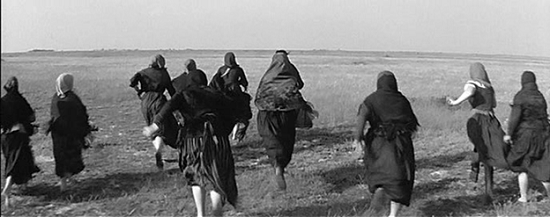
Fleeing women when one woman is identified
Five years earlier, Alfred Hitchcock had taken the then virtually unprecedented decision to kill off his female lead partway through Psycho (1960). In The Round-Up Jancsó does this with such regularity that it’s impossible to latch onto any single individual, despite the presence of recognizable actors such as Zoltán Latinovits and András Kozák, the leads in his two previous films. It rapidly becomes clear that every character, without exception, is a pawn in an exceptionally complex game of three-dimensional chess whose board lacks squares and whose rules change from minute to minute.
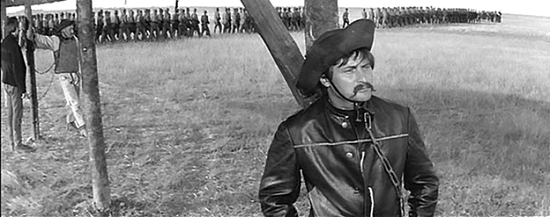
A prisoner tied to a pole
But, make no mistake, there are rules, and they’re certainly not arbitrary at the time they’re applied. No-one is immune from authority, not even those designated as authority figures (entire troops can be replaced at a moment’s notice), and a fatal bullet could hit at any moment, its origins an eternal mystery. This atmosphere of uncertainty (the film’s timescale is impossible to establish: it could be hours, weeks, months or years) means that a singled-out prisoner never knows whether he’ll end up dead or given an unexpected military promotion - and, if the latter, whether this is all part of the same macabre game and shouldn’t be taken at face value. The appearance of a full-scale military band just as a triple execution seems about to take place is both incongruously amusing and a wry comment on the ritualized nature of power: the unseen authorities seem to view the entire round-up as least in part as a gigantic Gesamtkunstwerk, a piece of conceptual art whose aesthetic impact outweighs the fact that it involves real human sacrifices.
Although The Round-Up can certainly be reduced to an 87-minute parade of torture and killing, by the same token My Way Home becomes a wartime buddy movie, and anyone who’s seen that film will recognize the absurdity. What’s remarkable about The Round-Up is the way Jancsó’s style so perfectly matches the substance, so that every manipulation and atrocity becomes a comment on similar practices within a far wider political context. There was a widespread assumption on the film’s original release in 1966 that Jancsó had constructed an allegory of Hungary ten years earlier, when the Hungarian authorities did some post-rebellion rounding-up of their own.
A series of "Hundred Favorite Films Forever"
28-Dec-2012
More by : P. G. R. Nair